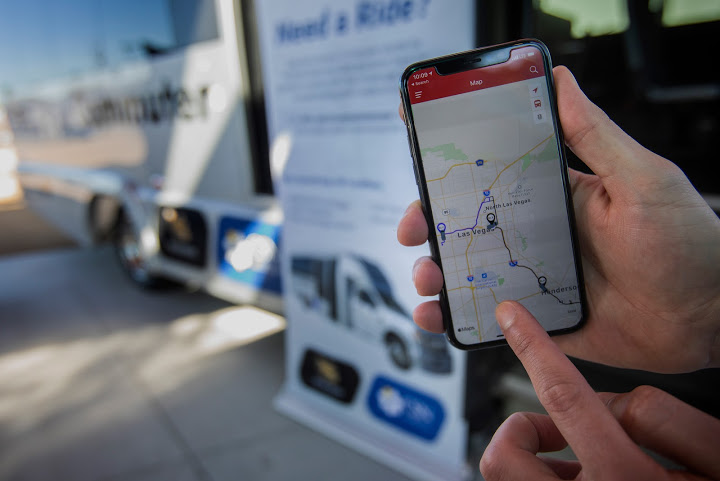How a new shuttle service could help close transportation gaps at Las Vegas community colleges

When Alexander Lum first enrolled at Nevada State College back in 2016, going to school meant taking a two-hour-long trip on public buses — for a trip that would have taken fifteen minutes by car.
“And for many of my friends that I made the first year, they were coming from way further -- North Las Vegas, East Las Vegas, Summerlin and they had a much longer commute times,” Lum said.
In the sprawling Las Vegas metro area — a sea of concrete reaching roughly 600 square miles from end to end — a lack of rail or other long-distance public transit options has long meant that the city’s colleges and universities evolved into the textbook definition of the so-called “commuter school,” with most students choosing to drive into class rather than live on campus.
But an often slow-moving system of public buses frequently operating in areas where public safety can be at question have created a choke point for many in the Las Vegas Valley looking to kickstart their college career without ready access to reliable personal transportation. According to a study conducted by CSN, as many as 82 percent of students who dropped out before finishing their degrees cited transportation as the primary issue.
Enter: the Campus Commuter. A new pilot program beginning this semester, the service will see three, 24-seat shuttles running fixed routes between three campuses of the College of Southern Nevada (CSN), Nevada State College (NSC) and the East Las Vegas Library. And at a cost of roughly $200,000 per semester split evenly between CSN and NSC, the shuttles will be run by a third party vendor at a cost of $3 per ride.
Launched with the fanfare of a ribbon-cutting ceremony at the East Las Vegas Library on Monday morning, the Campus Commuter shuttles will also provide students with app that will allow tracking of the shuttles in real time, as well as complimentary Wi-Fi for those students making the 40-minute-long trek between the shuttle’s two most distant stops.
For Lt. Gov. Kate Marshall, the push to find a solution to the ongoing transportation issues at Las Vegas community colleges had quickly become one of her first long-term projects after taking office last year. Marshall told The Nevada Independent that the transportation issue had been made clear to her campaign from students at CSN and NSC, with the scope of the problem quickly confirmed by transportation officials after she took office.
“[RTC said] it's really long standing, but we have never been able to solve it,” Marshall said. And so once I got elected, I said to my staff, we put everyone in a room. And I I told people when they came I said ‘look, if you're starting from ‘no,’ you can go. Because this is a meeting for ‘yes.’”
Marshall said that the issue was “particularly heartfelt” to her, pointing to her own experience riding two buses for more than an hour-and-a-half each day as she was ferried to a far-away Catholic school after her own high school lost its accreditation.
And in the time since the push to address transportation issues began, more data has become available on exactly how many students are being negatively affected by a lack of transportation access.
Still, identifying informational and logistical black holes in the creation of a college-based transportation service has long been a limiting factor in addressing the issue, according to RTC Southern Nevada CEO M.J. Maynard.
“Whether it's this service, on demand service or introducing a new route into the community, it always takes time,” Maynard said. “Normally you'd say well, in three months, is this where the ridership is and should be in transit, but that's not really how it works in transportation. It can take up one to three years for a route to fully develop.”
But among the administrative leadership at the community college level, the need for some sort of transportation solution had become clear throughout the last year.
“When you look at, for example, the growth of Nevada State College — and we’re the second fastest growing college in the country — almost all of that growth has been in central, east and North Las Vegas, not out in Henderson,” NSC President Bart Patterson said. “So it's kind of shocking, and we realized that in this transportation pilot, that when you look at like a bubble map of where students are located, we've doubled in student population in these areas just in four years.”
For the next year, the Campus Commuter program will function as a testbed, an opportunity to glean where the needs of students across Las Vegas really are, and a test of the system’s ability to be scaled beyond a pair of 24-seat shuttles.
But as the festivities of the ribbon cutting and the press conference that went along with it wound down, Patterson expressed an optimism about the project that had become pervasive among the dozen or so elected officials, school administrators and student leaders who had come to see the launch of the new shuttles.
“I feel I'm just so impressed that you can do an intergovernmental collaboration like this, and you can actually make it happen,” Patterson said. “You know, a lot of times when you start a project of this magnitude, there's just too many roadblocks that are put in the way of making it happen, and so I love these kinds of ideas that government works together and not in silos.”
Correction, 2:00 p.m. - An earlier version of this article incorrectly stated that the pilot program would operate two shuttles at no cost to students. It will, in fact, run three shuttles at a charge of $3 per ride.
